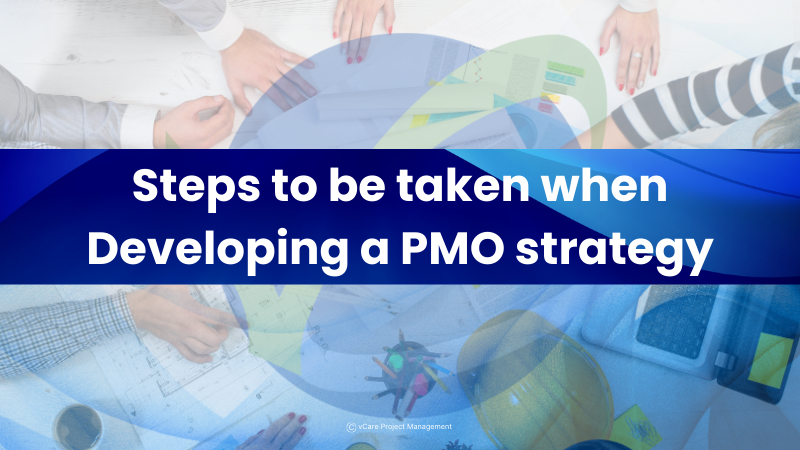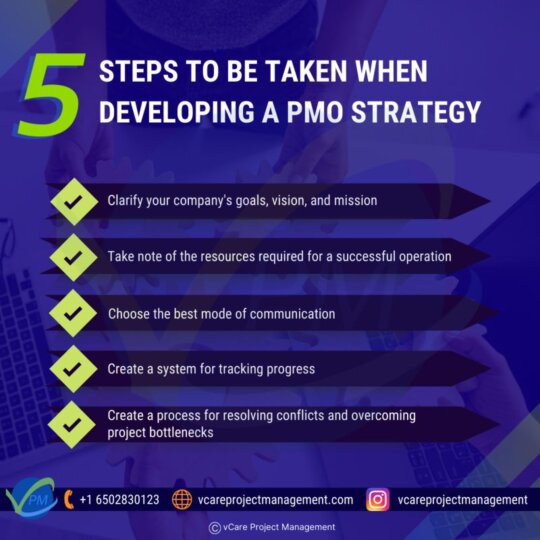
by vCare Project Management CW | Dec 6, 2024 | Industry Trends and Insights
Digital transformation is a strategy that modernizes business processes and introduces new services to engage customers, support employees, improve operations, and drive business value. PwC’s 27th Annual Global CEO Survey shows a growing need for transformation, with 70% of CEOs making changes in value creation, delivery, and capture over the past five years. IBM’s 2024 CEO Study reveals high pressure on executives to transform, with 72% viewing industry disruption as a risk rather than an opportunity. A business-centric approach to modernizing organizations through digital technologies is crucial for long-term business survival. Organizations must reinvent their operations and business models in the modern era, integrating digital technologies into all aspects to improve products and services, streamline processes, and introduce new revenue streams.
The global market for digital transformation technology and services is expected to reach $3.9 trillion by 2027, despite 70% of projects failing to meet objectives. To avoid falling into the 70% failure rate, organizations must make the right investments and adopt reversed leadership to foster resilience.

Driving Digital transformation
Peter Drucker’s theory emphasizes inverted leadership in businesses to promote resilience. He argues that the biggest danger in instability is not the turbulence itself, but acting on outdated thinking. To address this, companies must reject outdated methods and create adaptive structures that welcome change.
In today’s competitive environment, the Transformation Management Office (TMO) is critical for driving progress, building a value proposition, and providing comprehensive transformation guidance.
What Sets TMOs Apart?
The Transformation Management Organization (TMO) is a vital structure that oversees the planning, management, and monitoring of transformation activities. It unites diverse teams, driving accountability and clear direction. It serves as the link between strategy and implementation, ensuring the successful execution of a transformation initiative. The TMO’s key functions support the organization’s transformation program, making it valuable for businesses.
TMO and PMO
A Project Management Office (PMO) supervises specific projects inside a business, but a Transformation Management Office (TMO) controls the overall transformation path, which includes various projects and initiatives. A PMO manages project-specific goals, schedules, and resources to ensure timely and cost-effective completion.

TMO and PMO
Key differences include:
- Scope: TMOs manage large-scale changes involving several interconnected projects, whereas PMOs focus on a group of individual projects.
- Duration: TMOs are transient entities that dissolve during transformation, but PMOs can become permanent fixtures within an organization.
Transformation Management Office Importance:
- Aligns the company’s transformation plan with business goals.
- Provides control and monitoring in decision-making and risk management.
- Effectively manages organizational change, involves stakeholders, and promotes new procedures.
- Monitors and measures transformation progress to ensure expected benefits and ROI.
- Acts as a focal point for organizing activities and ensuring coordination across departments.
Bridging the Gap Between Expectation and Reality
Digital transformation is a major strategic objective for organizations, necessitating a fundamental shift in operations, customer interaction, and value delivery. This shift affects all parts of a company, from business model to culture, and necessitates extensive change management. Navigating these obstacles is critical for firms to adapt and succeed in the digital era. Change management involves preparing individuals and teams to adapt, often facing resistance, misunderstanding, and fear in large, fast-paced digital transformations. Understanding potential challenges can help organizations navigate this complexity efficiently. Strategic planning, effective change management, and a strong understanding of these challenges can position businesses for long-term success in the digital era.
Digital Transformation Challenges to Overcome
Digital transformation offers innovative opportunities for organizations but also necessitates critical thinking and reimagining core business aspects. Regardless of industry, from manufacturing to pharma, a few key challenges to consider when implementing digital transformation projects in 2024 include:
- Absence of a change management plan
A well-structured change management strategy significantly boosts digital transformation success, involving identifying root causes and building relationships with stakeholders and employees, thereby reducing the likelihood of project failure.
- Complex software and technology
Organizations undergoing digital transformation face challenges in complex enterprise software, data integration, and end-user experience.
- Driving the uptake of new tools and procedures
Organizations must provide comprehensive on boarding training and continuous performance support for new software implementations to help employees become productive and proficient with the new processes, overcoming resistance from tenured employees.
- Lack of a digital transformation strategy
Before implementing a digital transformation process, it’s crucial to understand the reasons for replacing legacy systems, the organization’s plan for advanced systems, and the readiness to migrate existing systems. Choose from various models based on improvement areas and company needs.
- Lack of proper IT skills
A tech worker shortage is impeding firms’ digital transformation efforts, with 54% claiming a lack of technically qualified employees. Cybersecurity, application architecture, software integrations, data analytics, and migration are all challenges that must be addressed by either outsourced or in-house teams.
- Security concerns
Enterprise organizations in data-sensitive industries face privacy and cybersecurity concerns due to digital transformation, which involves integrating data into a centralized system. Cyberattacks can target system vulnerabilities and poor setups, necessitating proactive mitigation plans and cybersecurity training for employees.
- Budget constraints
Digital transformation is a costly investment, with scope creep, consultation work, customer changes, and IT errors increasing costs. To manage this, organizations should identify long-term goals and ROI, determining what spending is too much and budget room for budget increase.
- Poor organizational structure
Organizational isolation can hinder collaboration, communication, resource allocation, and innovation in digital transformation initiatives, affecting decision-making and the flow of ideas.
- Measuring ROI
Since the advantages of projects involving digital transformation cannot be immediately perceived or measurable, calculating return on investment (ROI) can be difficult. Progress may be impeded as a result of uncertainty and a failure to invest in future projects.
Tips to Overcome Digital Transformation Challenges

Tips to Overcome Digital Transformation Challenges
- Invest in a digital adoption platform
Investing in a digital adoption platform (DAP) is vital for successful digital transformation projects, as it provides adequate on boarding, training, and support for employees.
- Establish a change leadership team
Identify influential, innovative, and trustworthy employees in your workforce and form a cross-functional change leadership team to create a vision for digital transformation aligned with business goals, allowing organizations to take a proactive approach and accelerate change.
- Hire a digital transformation consultant
Digital transformation involves realigning core processes, tools, and experiences, often challenging organizations with a lack of internal change agents. Hiring a digital transformation consulting company offers a proven framework and success-based framework for successful change.
- Align business objectives with the digital transformation plan
An organization’s digital transformation should prioritize understanding customer needs, pain points, and friction areas in offerings, products, and services. Analyse current processes to identify outdated systems and align with core business goals, empowering employees, overcoming customer experience challenges, and driving revenue.
- Be agile
Digital transformation projects require organizational vulnerability, as leaders must adapt and innovate in a rapidly changing technology landscape. Being agile means pivoting and seizing opportunities, and embracing new processes, tools, and practices, even if they’re already underway.
- Encourage employee feedback
Employee involvement in digital transformation can help organizations overcome challenges by involving them in decision-making, identifying obstacles, and devising effective solutions, fostering a sense of ownership and accelerating the success of digital transformation initiatives.
- Continue to monitor and adapt
For real-time changes, alignment with corporate objectives, efficient resource allocation, and resolving possible problems before they become worse, it is essential to continuously monitor, measure, and evaluate digital transformation projects.
Leadership in Transformation: The CTO’s Role
According to the PwC CEO Survey, 22% of UK CEOs are predicting their current business model will not last for the next decade due to changing consumer and regulatory needs, talent shortages, climate, digitalization, economy, and geopolitics. This necessitates immediate changes in the supply chain, operational model, product portfolio, strategy, and culture.
The growth of strategic leadership skills among Chief Transformation Officers (CTOs)
Transformation is crucial for organizations, but there is no clear leader. Three approaches exist: top-down, devolved, and dedicated.
- Top-down involves the CEO leading, and delegating to C-Suite colleagues, while devolved involves other C-Suite members rotating.
- The devolved approach involves other C-Suite members, potentially on rotation.
- The third approach involves a dedicated individual focused on developing and delivering the transformation strategy.
The need for a dedicated transformation leader depends on the scale, complexity, and ambition of the strategy. As transformation becomes ‘business as usual’, organizations are increasingly creating board or C-suite roles like transformation director or Chief Transformation Officer.
The demand for a dedicated and elevated transformation leader
A transformation leader is responsible for driving an organization’s change ambitions, elevating them to the top, and ensuring transformation remains a key agenda item. They must set the tone, challenge current wisdom, and integrate functional and organizational priorities like sustainability, purpose, and digital transformation to create a viable future. The leader’s role involves gathering insights, identifying change impetus, devising a vision, and designing key steps.
Top leadership skills for a CTO Role

Top leadership skills for a CTO Role
- Strategic thinking
A CTO must be able to think strategically to foresee market trends, develop a strategy, communicate clearly, and compile a variety of perspectives. This skill aids with innovation, value creation, and competitiveness.
- Technical competence
A CTO must possess technical expertise, which calls for an extensive understanding of modern tools, technologies, and frameworks as well as the capacity to assess, choose, and put into practice scalable, secure, and dependable solutions.
- Team leadership
CTOs require strong team leadership skills to recruit, train, and motivate diverse teams, foster collaboration, and provide clear direction. This builds trust, engagement, and productivity, enhancing productivity.
- Business acumen
CTOs must possess business acumen in order to analyze effect, match technological solutions with business strategy, and comprehend the market, consumers, and competitors. Making informed, data-driven, and customer-focused decisions is facilitated by this ability.
- Communication skills
CTOs require strong communication skills to effectively communicate their vision, strategy, and objectives, establish rapport, credibility, and influence, and actively listen, inquire, and empathize with others.
- Learning agility
CTOs must learn agility, adapt to changing situations, learn from successes, embrace new challenges, foster a learning environment, seek knowledge, and seek feedback to grow, innovate, and improve.
How the CTO and TMO collaborate to advance organizational success?
The CTO and TMO work together to align technology strategies with enterprise-wide transformation goals, with a focus on innovation, scalable solutions, and leveraging new technologies for competitive advantage. Through advanced analytics and efficient project and change management, they maximize resources, create a balance between technical and operational requirements, and promote data-driven decision-making. Through this collaboration, technology is certain to play a significant part in transformation, fostering agility, operational effectiveness, and quantifiable results throughout the company.
Here’s how they work together in detail:

Effective collaboration between CTO and TMO
- Strategic Alignment
The CTO and TMO collaborate to develop a long-term technology roadmap, aligning IT and operational changes with the organization’s strategic vision and ensuring value.
- Driving Innovation
The CTO implements new technologies to enhance operational efficiency and customer experiences, while the TMO facilitates their integration within the organization, collaborating on technical expertise.
- Execution of Transformation Initiatives
The CTO provides tools for transformation projects, while the TMO manages them efficiently, ensuring milestones are met and the technical enablers are effectively utilized.
- Resource Optimization
In order to prevent redundancy and guarantee the economical deployment of technology and human capital, the CTO and TMO collaborate to optimize technical resources, assign resources for transformation initiatives, and work collectively.
- Change Management
The CTO manages technical challenges and resistance during technology implementation, while the TMO manages organizational resistance and ensures cultural buy-in for changes.
Building the Team Behind the Transformation
Effective digital transformation strategy requires assembling the right team, considering factors like experience, education, skillsets, influence, and teamwork abilities. Digital teams are led by C-level executives, who may hold titles like CIO, CTO, or COO, and have other responsibilities. The CEO appoints the leader for all digital transformation initiatives, based on their view of the process. Finding the right team members is a challenge in digital transformation projects.
What roles do digital transformation teams need?
Digital transformation requires nine key positions, but on average, 12-20 people are on each team, with multiple people working within each role in most companies.

What roles do digital transformation teams need?
- Business-technology liaisons
Business technology liaisons work with business unit executives to identify opportunities and challenges by examining business models, customer experience, and technology strategy as part of initiatives to transform their businesses.
- Technologists
Technologists identify business issues for transformation, select appropriate technology and providers, and evaluate the technical success of digital transformation projects.
- Implementation leads
This role involves leading the digital transformation roadmap, focusing on technology and process change implementation, with additional daily implementations.
- Marketers
IT staff often implement new technology to enhance customer experiences, but employees often lack understanding. Marketers should understand the project’s goals, technology impact, and effective marketing strategies to engage employees, customers, and business partners, ensuring customer engagement.
- Business processes experts
Business process experts are essential for digital transformation, optimizing workflows, recommending AI, machine learning, and automation, and fostering new digital strategies for a digital-forward approach.
- Security and compliance specialists
Digital team leaders should involve security and compliance specialists from the start to avoid potential project halts due to potential security policy violations, ensuring a smoother and more secure project.
- Project managers
Project managers develop detailed plans, maintain staff, schedule, and budget, set meetings, and schedules, raise red flags, and reset expectations to ensure the project stays on track.
- Financial stakeholders
Digital transformation initiatives are financed by financial stakeholders, who also persuade other budget holders to obtain further financing. They demand weekly, monthly, or quarterly updates to monitor progress and ensure the budget is well spent. C-level executives often serve as ultimate financial stakeholders.
- Evangelists
Evangelists use their influence and communication skills to generate excitement and secure funding for projects, often through well-received internal blogs and videos, and provide honest evaluations to budget control authorities.
Ways to select the best team for a business transformation
Building a team for technology transformations requires effort, approval from supervisors, and discipline. Best practices include finding suitable individuals, ensuring discipline, and integrating them into daily tasks.

Ways to select the best team for a business transformation
- Identify the roles and skills needed
Define roles and skills for your business transformation team, including project management, change management, business analysis, technical skills, communication, and stakeholder engagement, considering their authority and responsibility, and their interaction with the organization.
- Evaluate your current talent pool
Utilize various assessment methods to evaluate your talent pool, focusing on adaptability and learning potential, and consider external recruitment for skill gaps or fresh perspectives.
- Align the team to the mission and objectives
Select team members and align them with business transformation goals. Communicate project purpose, scope, benefits, risks, organization strategy, values, expectations, accountability, measurement, reward, and resources. Provide support and training for effective performance.
- Promote a culture of collaboration and innovation
Foster a culture of collaboration and innovation within your business transformation team by encouraging open communication, experimentation, and improvement. Celebrate team achievements and milestones to select the best team for your transformation and increase the chances of achieving desired outcomes.
Speed vs. Sustainability: Achieving the Right Balance
Striking the correct balance between speed and sustainability is the primary barrier to implementing organizational change. On the one hand, it may be swiftly implemented, providing competitive advantages and results right away. On the other hand, long-term success and preventing exhaustion or inefficiency will depend on ensuring that improvements are sustainable. A transformation management office is essential in striking this delicate balance to ensure both immediate effect and long-term value.
Need for Speed in Transformation
In transformation projects, speed is typically the primary concern, particularly in settings where external pressures like market rivalry, technology disruption, or regulatory changes need quick reactions. Quick action might offer several advantages:
- First-Mover Advantage: Quick deployment can help a company surpass its rivals, increase market share, or reshape industry norms.
- Momentum and Engagement: Stakeholders are excited by quick wins, which generates momentum for more change.
- Crisis Management: Speed may be a useful reaction to stabilize operations and preserve company flow during crises like recessions or supply chain disruptions.
- Customer demands: In general, meeting evolving customer demands necessitates a quick adoption of new procedures or technology.
Yet, the need for speed comes with hazards, such as making rapid choices, failing to involve stakeholders, and putting in place short-term solutions that might not last.
The Case for Sustainability
The focus of transformation sustainability is on making adjustments to the systems, procedures, and organizational culture in a way that will yield long-term benefits. The following are some advantages of sustainable change:
- Cultural Incorporation: Because employees can adapt and adopt new behaviours, changes that take into consideration the company culture have a higher chance of success.
- Resilience: Systems and procedures that are able to adapt over time and withstand future disruptions are the result of sustainable adjustments.
- Cost-Effectiveness: While such quick adjustments may lead to waste and rework, sustainable projects are made to be as efficient as possible while maximizing return on investment.
- Establishing Stakeholder Trust: Stakeholders will remain committed and helpful if a progressive approach is taken to gain their confidence.
This approach to sustainability has the drawback of lengthening timeframes, which gives competitors a chance to outstrip them or opportunities to fall away.
How the TMO Achieves the Balance
An effective TMO makes sure that sustainability and speed are beneficial not detrimental, components of a successful transition. A TMO accomplishes this balance in the following ways:

How the TMO Achieves the Balance
- Setting Initiative Priorities
Transformation initiatives undergo a thorough study by the TMO, which then classifies them based on their long-term worth and urgency. The TMO guarantees that important objectives are fulfilled without sacrificing the sustainability component by distinguishing between urgent and non-urgent initiatives that may be phased in.
- Agile Methodologies
Using agile frameworks, the TMO promotes iterative progress. In this manner, the company may provide immediate results while also gradually improving procedures in the direction of long-term goals.
- Integration of Change Management
Rapid adoption and deep integration into the organization’s culture are two goals of change management techniques implemented through the TMO. As an example:
- Short-term: Employees will be assisted in understanding the instantaneous advantages of changes through training and direct communication.
- Long-term: Constant interaction via feedback loops guarantees acceptance and embracing change.
- The Planning of Resources
Rapid projects usually demand significant resource expenditures, while sustainable projects call for the balanced use of the same. Resources are managed by TMO to prevent burnout, overstretching, or underinvestment in vital projects.
- Data-Driven Insights
A TMO may make quick course corrections without compromising long-term objectives like employee engagement or consumer satisfaction by using data to monitor transformation progress in real time.
- Balancing Rewards and Risks
The risks of moving too quickly or too slowly are examined by the TMO. Using risk assessments and backup plans that balance thoroughness and speed, ensures that the company moves at the proper pace.
Crucial Elements of Success
Here are some action-oriented tactics for striking a balance between flexibility and discipline:
- Set Clear Objectives: Specify both immediate and long-term objectives. To evaluate progress and effort alignment, use them as checkpoints.
- Build Leadership: Give leaders the power and resources they need to make choices that promote sustainability and speed.
- Foster an Experimentation Culture: Encourage small pilot studies and experiments that can yield rapid insights without running the risk of more significant failures.
- Transparency: Explain the rationale behind the schedules, resource distributions, and decision-making procedure to all parties involved.
It is the practice of balancing speed and sustainability via strategic oversight, meticulous preparation, and adaptation. A Transformation Management Office is ideally positioned to balance these goals, allowing firms to adapt to current difficulties while maintaining long-term stability. With the appropriate methodology, businesses may achieve transformative success that is both timely and sustainable.
The Future of TMOs in a Disruptive Landscape
Transformation Management Offices (TMOs) evolve with enterprises as they traverse a fast-changing world marked by technological developments, transformations in worker demographics, and global issues. Today, in this age of disruption, TMOs have evolved from typical project monitoring bodies to critical facilitators of innovation, flexibility, and long-term sustainability.
Emerging Innovations: The 15 tech trends
Organizations increasingly turn to data analytics and artificial intelligence (AI) to assist them make business choices. When it involves incorporating artificial intelligence for resource efficiency, process automation, and predictive analytics, TMOs are essential. This integration can improve decision-making, and operational efficiency, and lead digital transformation initiatives. Hybrid workforces are also changing the way organizations work, necessitating inclusive and collaborative transformation. TMOs must embrace digital tools and communication platforms that enable virtual collaboration across global teams. This global collaboration helps businesses remain competitive and agile in the fast-paced market.
The McKinsey Technology Trends Outlook 2024 categorizes 15 trends into five groups: AI revolution, digital future, compute and connectivity, cutting-edge engineering, and a sustainable world, assessing their status through innovation, interest scores, and adoption levels.

Emerging Innovations: The 15 tech trends
- Generative AI
Unstructured data, such as natural language and pictures, are used by generative AI systems like ChatGPT to create new audio, code, images, text, simulations, and movies.
- Applied AI
AI technologies utilize machine learning models to solve classification, prediction, and control problems, automate activities, enhance capabilities, and improve decision-making.
- Industrializing machine learning
The industrializing machine learning trend entails a fast-growing ecosystem of software and hardware solutions that accelerates and lowers the development, implementation, and maintenance of machine learning systems.
- Next-generation software development
Next-generation software development utilizes advanced tools and technologies for efficient code deployment, automated code generation, testing, refactoring, and translation, thereby enhancing application quality and development processes.
- Digital trust and cybersecurity
Digital trust and cybersecurity include trust architectures, digital identity, cybersecurity, and Web3, which allow enterprises to develop, grow, and retain stakeholder trust.
- Advanced connectivity
Low-Earth-orbit satellites, 5G and 6G cellular, Wi-Fi 6 and 7, and wireless low-power networks are all examples of advanced connection.
- Immersive-reality technologies
Immersive-reality technologies enable real-time interactions in three-dimensional virtual worlds, ranging from fully computer-generated VR to mixed reality and AR. They use spatial computing to interpret physical space and simulate data, objects, and people addition.
- Cloud and edge computing
Cloud and edge computing involves distributing workloads across locations like hyperscale data centers, regional centers, and local nodes to optimize latency, data transfer costs, data sovereignty, and security.
- Quantum technologies
Quantum-based technologies utilize quantum mechanics’ unique properties to perform complex calculations faster, secure communication networks, and produce higher-sensitivity sensors than classical counterparts.
- Future of robotics
The future of robotics will see advancements in robots from fixed-purpose tasks to adapting to real-life inputs with increasing autonomy and dexterity.
- Future of mobility
The efficiency and sustainability of land and air transportation are intended to be improved by mobility technologies, such as electric and driverless cars, urban air mobility, and ACES technology.
- Future of bioengineering
Bioengineering is the application of engineering concepts to biology, using technology breakthroughs to enhance health and human performance, restructure food value chains, and develop innovative offers.
- Future of space technologies
Space technologies include satellites, launchers, and habitation systems that enable new space activities and services.
- Electrification and renewables
The electrification and renewables trend encompasses the entire energy production, storage, and distribution value chain, utilizing renewable sources like solar and wind power, clean energy sources, and energy storage solutions.
- Climate technologies beyond electrification and renewables
Climate technologies aim to reduce resource consumption by removing CO2 from the atmosphere or producing materials and inputs with lower carbon equivalents.
TMO as an Enabler of Innovation and Adaptation in a Constantly Changing Environment
TMOs are becoming key drivers of innovation in a world marked by constant disruption. They help projects remain responsive and adaptable, such as during the pandemic when they focused on remote work transitions and digital-first strategies. By fostering a culture of continuous improvement and agile methodologies, TMOs enable organizations to innovate at scale, test new ideas, assess emerging technologies, and adapt to the business environment without losing sight of long-term objectives. In the future, TMOs will become centres for experimenting and scaling innovations.
The Changing Role of TMOs in a Post-Pandemic World
Organizations’ approaches to change have been permanently impacted by the COVID-19 pandemic A new function has been introduced to the TMO in the post-pandemic environment with reference to crisis management, recovery, and restructuring organizational structures. TMOs are increasingly in charge of managing hybrid work arrangements, supervising the change to more digital-first models, and negotiating emerging issues like cybersecurity, employee well-being, and changing consumer expectations.
Additionally, post-pandemic methods call for greater function and geographic cooperation, which makes a strong TMO even more essential. Leading resilience in an era of future disruption is now the office’s responsibility in order to keep the company flexible and responsive. As businesses consider their post-pandemic needs, TMOs must emphasize adaptability, foster innovation, and take on the role of sustainability champions.
Conclusion
Investing in the Future of Transformation Management Offices (TMOs)
Organizations that implement a Transformation Management Office (TMO) now will not only survive but thrive in future difficulties. Maintaining a competitive advantage requires employees who are committed to driving change and ensuring that transformation efforts are executed seamlessly. TMOs are critical in today’s fast-paced, digital-first business environment because they oversee and align transformation activities, balance rapid wins with long-term development, manage evolving technologies and promote continuous improvement. They facilitate innovation, help firms navigate digital transformation, maximize resources, and successfully manage change. TMOs can help firms be resilient and adaptable in the face of upheaval by catalysing adaptation and innovation.
Call to Action for Leaders
Leaders must invest in a Technology Management Organization (TMO) to navigate the complexity of the modern corporate world, which includes hybrid workforces, AI-driven decision-making, and a quickly changing competitive landscape. Proactively deploying TMOs can help firms navigate these changes, unleash new growth prospects, and assure long-term success.
TMOs will play a growing significance as firms adapt to a world that is changing all the time. In the years to come, TMOs will be the driving forces behind organizational change, from innovation and adaptation to AI-driven decision-making and hybrid workforce management. TMO will emerge as a strategic partner that helps companies not just survive but flourish in this disruptive environment as they confront an increasingly uncertain future.

by vCare Project Management CW | Nov 27, 2024 | Industry Trends and Insights, Leadership in Project Management, Project Management, Strategic Management and Alignment
Introduction: Navigating the VUCA Landscape
As the world is moving towards hyper-active technological disruption, its high time for Project Managers to learn effective ways to deliver value in a VUCA environment. There are plethora of examples demystifying the concept of VUCA. But very few revitalizing its impact on project management and value delivery. This article is framed to have a clear picture on how it works, the balancing act, mindset and delivering value from a Project, Program, Portfolio Manager Perceptive.
Understanding VUCA
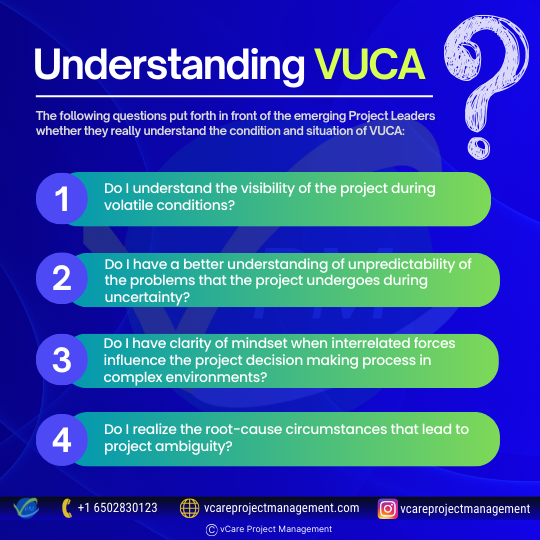
Understanding VUCA
Let’s get started with what VUCA stand for – Volatility, Uncertainty, Complexity, Ambiguity. It was formally developed by US Army War College in 1987 after the Cold War, to reflect how to oversee complex multilateral world situations. The acronym VUCA is derived from the leadership theories of Warren Bennis and Burt Nanus. Delivering value have direct correlation with the economic equation of the countries in which projects involved. The dynamics of environment changes impact the project success direction. Those adversaries needed to handle with focus mind, determination, perseverance by the Project Leaders. The following questions put forth in front of the emerging Project Leaders whether they really understand the condition and situation of VUCA:
- Do I understand the visibility of the project during volatile conditions?
- Do I have a better understanding of unpredictability of the problems that the project undergoes during uncertainty?
- Do I have clarity of mindset when interrelated forces influence the project decision making process in complex environments?
- Do I realise the root-cause circumstances that lead to project ambiguity?
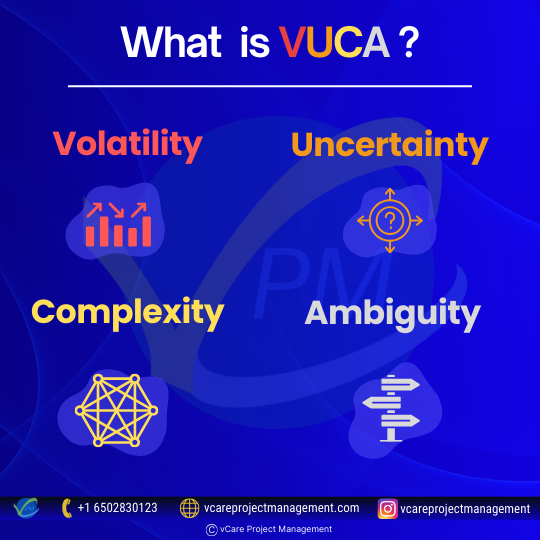
What is VUCA?
All these four questions streamline Project Manager to understand his unknowns – unknowns and better deal with this environment. Let us have a briefing on VUCA,
· Volatility: The rate of change or churn in business environment which directly affects the daily operations of the project. The Project Managers will always be in bed of thorns to mitigate the volatile situation and try to settle into normal rhythm.
· Uncertainty: The world is full of surprises when delivering value, that too for project managers it will be high potential for surprise due to lack of predictability in an uncertain environment. They need to have good assumptions capabilities to plan for future uncertainties.
· Complexity: Diverse global supply chain gets impacted directly with geopolitical, economical, dynamics of industries add complexities to the project success. Better observing of interrelated forces is need of the hour for the Project Managers.
· Ambiguity: The common misunderstandings and unclear realities cause project delays affecting the value delivery process. It naturally makes it difficult to construct risk mitigation plans.
The Impact on Project Management in VUCA World
VUCA influences project, program, and portfolio management, particularly in high-stakes environments. Whether it is a good sign or bad sign depends on the mindset of the Project Manager. Can we eliminate VUCA is a big question mark among the Project Leaders. We need collective responsibility when handling VUCA and one step at a time approach. Agile approach is good to proceed with but not the absolute one to stick on. As a project manager we need to dynamic and adapt to the changing environment and be hybrid to mitigate the risks and challenges VUCA environment brings into the project.

Some tips for Project Manager to thrive in such environments
Some tips for Project Manager to thrive in such environments:
Be Collaborative & Co-creative: Project Managers need to have meaningful collaborations with their team members. Their options, problem solving instance should be appreciated and involved in the decision-making process. Positive collaboration leads to positive co-creation combining for best value-based project delivery.
Be Innovative & Creative: Developing child-like mentality with outlook of creativity Project Managers can do wonders with innovations in their projects. Both have close twin knots, losing one will automatically supress the other.
Be Sensible & Communicative: Here we trigger the sensibility in voicing with clarity to your entire stakeholders – sponsors, team members, top management, external and internal state actors. Project Manager’s voice should be uniform throughout the top and bottom of the pyramid. This helps to face disruption with united response.
Be Flexible & Adaptable: Project Managers need to be flexible as grass, dancing to changes in project environment in the VUCA world. Adaption is a must from all levels which need patience and fair amount of training from the organization.
VUCA environment should be seen an opportunity rather than a challenge for organizations to thrive. These tips will be helpful for Project Managers to position themselves with resilience in such environments.
Strategic Leadership in a VUCA World
According to Wikipedia, Andrew Porteous quotes “Failure in itself may not be a catastrophe. Still, failure to learn from failure is.” Project leaders must understand there is no fool proof techniques to address VUCA environments. The only solution is fail fast, fail safe and learn from failures. While this mindset is difficult to grasp but have a sense of community to better positive predictions. Both introspections and evaluations needed to navigate and thrive in such environments. Connecting the dots between strategy and delivery results in better project outcomes. The Project Leaders performs the balancing act between the two. How well they balance need greater amount of critical analysis.
Cultivating Versatility:
Developing adaptable leadership styles to manage unpredictable challenges aids the Project Leaders to manoeuvre better reliable strategies for projects. A pragmatic approach of leadership will enhance the decision-making process. The project duress created from the realms of political, economic, technical, social, market, nature calamities like Covid-pandemic gives a moral responsibility for leaders to rethink their leadership style. The harder problems of technological imbalances due to Artificial Intelligence (AI) making it difficult to craft strategies.
According to MIT Sloan Management Review, change management and emotional intelligence top the list of skills leaders to focus to steer the teams for project success. There is a serious limitation and notion of inadequate performance of leadership in these skills. So, organizations can address such extreme mishaps in their leaders by developing versatile leadership. Versatile leadership is forgoing continuous adjustments to their behaviour, meticulously applying right approach, to the right degree, for the circumstances at hand.

Cultivating Versatility
The Versatile Leader mind works in the absence of imbalance, fostering clear vision to handle tough environments. F. Scott Fitzgerld, in his 1936 essay “The Crack-Up,” quotes “the test of a first-rate intelligence is the ability to hold two opposed ideas in the mind at the same time, and still retain the ability to function.” This is the major challenge a Versatile Leader should pass by adoring wide and flexible range of behaviours
- The Role of Sensemaking: The root causes of imbalance is due to strategic-operational dualities faced by the leaders. The skill of sensemaking enables Project Leaders to understand ambiguous, equivocal or confusing events in VUCA environment. Sensemaking techniques aids for interpreting complex situations and making informed decisions in shifting markets. These capabilities help leaders to drive organizations forward, by having a clear 360-degree vision on environment they work upon.
- Accepting Chaos as a Strategy: Leaders should start embracing chaos to thrive in unordered environments where traditional methods are insufficient. From exponentially increasing technological advancements, economic and political aftershocks, disruptions like these have significant impact on the global supply chain. A well-engineered leadership mind will craft chaos as a strategy framework to streamline business operations for smooth project handling.
Balancing Speed with Thoughtfulness
In the fast-paced rapidly changing environment balancing speed with thoughtfulness is a daunting task for Project Managers. Ambitious targets in short durations leads to disrupt project progress leading to project delays and later project failures. Setting vibrant goals dominate the modern workplace. The thoughtfulness of leaders to change their conventional wisdom towards goal setting is key.

Balancing Speed with Thoughtfulness
As goals drives strategic execution of value delivery, interdependencies of silos plays a vital role for balancing the delivery value chain. A word of caution should always be there in mind of Project Managers when balancing speed with thoughtfulness. Goal setting should be FAST (frequent, ambitious, specific, and transparent) rather than SMART (specific, measurable, achievable, realistic, and time-bound) in VUCA environment.
The Danger of Speed-Centric Goals:
Creating value quickly is the new paradigm shift, organizations seek to transform all or part of their businesses. Speed-centric goals lead to high performance of trajectory for the organization but do have the adversity of total failure push back. Proper prioritization of risks is needed to achieve rapid time-bound outcomes. The Project Leader should construct a rigorous cluster of plans in short-duration sprints to overcome potential long-term consequences with thoughtful value delivery.
Prudent Risk Management vs. Aggressive Growth:
Too match the pace of market demands in the digital age, the pivot of risk-taking is quintessential for Project Leaders safeguard the organizational immune system. In today’s scenario avoiding risks is not a priority, leaders need to be proactively involved in identifying, evaluating, and strategizing risk mitigation plans. Risk-taking foster growth and innovation in VUCA world. Leaders should sharpen their risk management capabilities and be prudent. A prudent risk taker maintains calmness during uncertain times and able to show resilience with sound and rational decision-making. Rather than focusing on aggressive growth, Project Leaders need to navigate a path to smart growth. Organization’s reap multiple benefits by having “The Growth Corridor” balancing between minimum growth and maximum growth to drive innovation and survival at the marketplace.
Enhancing Communication and Team Adaptability
Organization’s stability dismantled when fear of disorders overlooks in the mind of employees from the top to bottom management. To overcome stagnation and steer through treacherous waters of VUCA, the Leader should communicate effectively. VUCA communication leans towards sleek perfection, setting clear direction and rallying behind employees’ voice. Leaders unify team adaptability call to action of cohesive strength to face the battle fluctuations and achieve value delivery.
Clear Communication in a VUCA Environment:

Clear Communication in a VUCA Environment
Effective communication is crucial yet challenging in VUCA world. Shifting dynamics of the workplace needs strategies not only communicate information clearly but make sure to reduce friction across the realms of the various verticals and horizontal in the organization. Let us walkthrough some of the effective VUCA Communication tips:
· The Importance of Clarity: Clarity in communication helps reduces misunderstandings, align team efforts, and reduce the friction that often arises in high-stakes, rapidly changing environments.
· Tailoring Communication to the Audience: Understanding the audience’s pulses to streamline communication.
· Leveraging Multiple Channels: Avoid bottlenecks and constraints by leveraging multiple channel communication.
· Encouraging Open Dialogue: Open dialogue fosters a culture of sensibility leading to more transparency, trust, and accountability, which are vital in uncertain environments.
· Continuous Feedback Loops: Creating continuous feedback loops allows teams to quickly adjust their communication practices as the environment changes.
· Adaptability and Flexibility: Both adaptability and flexibility not only improve clarity but also helps to maintain morale and cohesion among teams facing uncertainty.
Continuous Improvement of Skills:
Keep pace with the evolving demands of a VUCA world, creating a learning organization is needed. It should need to be embedded into organizational culture fostering continuous improvement. According to Klaus Schwab in The Fourth Industrial Revolution, the integration of advanced technologies like Artificial Intelligence (AI) and Internet of Things (IoT) into everyday business processes means that the skills required today may be obsolete tomorrow. Continuous learning ensures that Project Managers can adapt to these rapid changing shifts, maintaining their relevance and effectiveness in VUCA world.
Conclusion: Thriving Beyond Boundaries
Embedding resilience into the Project Manager to thrive in VUCA world is a never-ending experience and experiment that organization keeps on retrospect for betterment. Delivering value in an increasingly boundaryless world, creating positive hopes of survival lies in the hand of versatile leaders. Such architecting leaders able to cultivate better systems, structures, culture, possibilities, and autonomous decision making to teams, in chaos.
The Project Leaders should develop: sensemaking with life-long learning, balance speed with thoughtfulness, managing risk with growth mindset, prioritize communication, skill development, foster a culture of continuous improvement, and embrace versatility, to deliver value in VUCA world.
#VUCA #ProjectManagement #StrategicLeadership #BusinessResilience #AgileMindset #RiskManagement #VUCALeadership #ProgramManagement #ProjectSuccess #AskDharam #DharamSingh
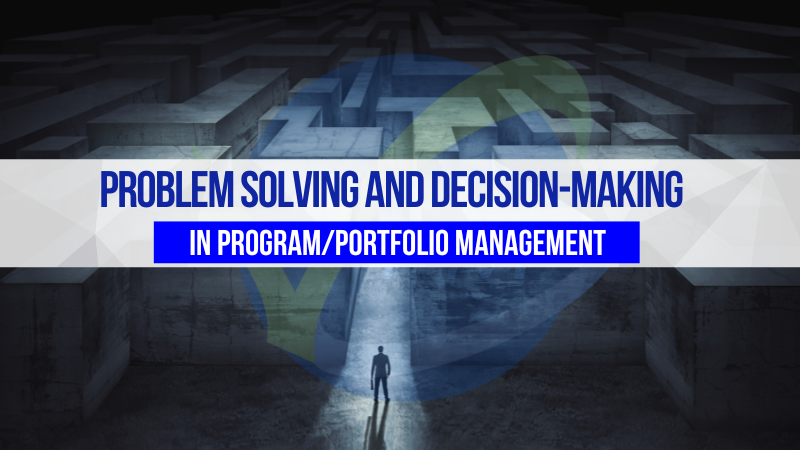
by vCare Project Management CW | Oct 27, 2024 | Industry Trends and Insights, Leadership in Project Management, Project Management
Program/portfolio managers must make significant and minor decisions in the ever-changing project management environment. In many instances, their judgments and actions due to their more critical decisions may significantly influence their well-being and the prospects of clients and team members. Moreover, such decisions can impact the very nature of our jobs and even the lives of others who rely on them.
As equal to decision-making, problem-solving skills are essential in project management. Problem-solving is a project management skill that combines creative thinking and strong analytical abilities to assist effective problem solutions. This skill allows the project leader to look at challenges from a different angle and assist in designing and implementing successful solutions for making great decisions.
It’s easy to understand how, in problem-solving, recognizing simple solutions to complicated challenges might benefit the project and the company. Still, not all competent Project Leaders are capable of doing so. To be an effective problem solver and decision maker, the program/portfolio manager must possess specific skills and techniques to manage the project successfully.
Understanding the Decision Making Process in Project Management
All managers and other interested stakeholders must have a thorough grasp of decision-making in project management. The project will only then be able to progress toward the final delivery phase while maintaining the established timelines. The project runs a significant risk of stagnating or moving extremely slowly in this absence.
However, many businesses need help on several fronts because they need to recognize the value of decision-making in their management teams.
A McKinsey survey found that roughly 80% of professionals thought their firms’ decision-making processes could have been more efficient. Furthermore, the firms that demonstrated superior decision-making skills and topped the survey had better financial and performance outcomes.
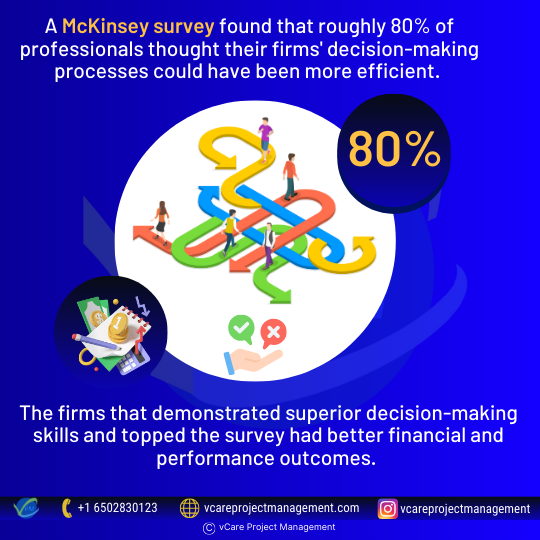
McKinsey survey
Decision-Making Types in Program/Portfolio Management
Decisions need to be made regularly in project management. Most are minor, but others are significant and will determine whether the project succeeds or fails. The same applies to program/portfolio management. Final choices can be reached using either an intuitive or logical method or a combination of the two. More intricate conclusions typically need a more formal, systematic approach incorporating intuition and reasoning. Not all decisions are the same. Management must make many decisions during a project, and each decision-maker is unique. The most common ones are listed below:
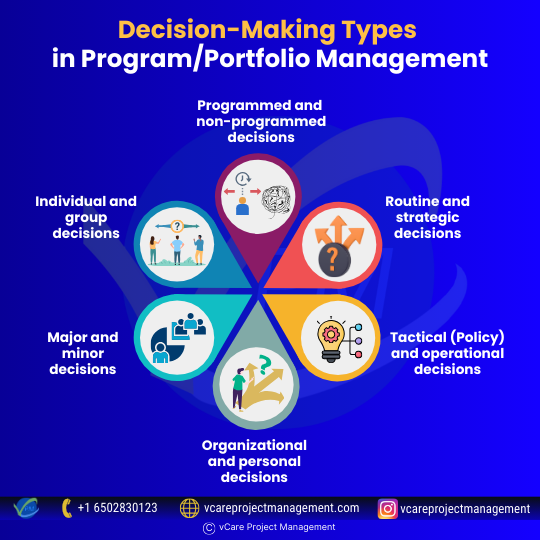
Decision-Making Types in Program_Portfolio Management
1. Programmed and non-programmed decisions
Programmed decisions are concerned with problems of a repetitive nature or routine type matters. For example, decisions of this type may pertain to purchasing raw materials, granting leave, and supplying goods to the employee. Non-programmed decisions are made in challenging situations with no clear solution. These decisions need more attention, resources, and time and are usually made at a higher level.
2. Routine and strategic decisions
Routine decisions affect the overall operation of a project and can be made rapidly. Within the broad policy framework of the project manager or the organization, ample powers are granted to lower ranks to make these decisions. However, strategic decisions are essential and affect objectives, organizational goals, and other important policy matters. These decisions usually involve a program’s orientation or huge investments in portfolios, are non-repetitive, and are taken after careful analysis and evaluation of alternatives.
3. Tactical (Policy) and operational decisions
Portfolio managers make policy decisions that have a long-term impact on the functioning of the concern. For example, decisions regarding how many projects can be run each time according to the budget are policy decisions. On the other hand, operational decisions relate to the day-to-day functioning or operations of the business. Middle—and lower-level managers make these decisions. For example, decisions concerning the payment of bonuses to employees are operational rather than policy decisions.
4. Organizational and personal decisions
When an individual decides their responsibilities and tasks within the project, it is an organizational decision. But, if the individual decides on personal matters, it’s a personal decision. The authority to make organizational decisions may be delegated, whereas personal decisions cannot.
5. Major and minor decisions
A decision related to increasing the number of resources by 50% is a major decision. A minor decision, for example, is that the superintendent can purchase office stationery.
6. Individual and group decisions
When an individual decides within an organization, it is known as an individual decision. However, when it comes to more crucial decisions, more stakeholders need to engage and assist in making a decision. Therefore, it is interesting to investigate in which cases a project manager should involve other project members.
Decision-making Tools and Techniques
Project managers frequently employ additional measures to support the validity of their decisions. While the fundamental concepts remain the same, hundreds of distinct ways and tools are available. A mixture of these strategies can also be employed to make better decisions. Project managers would benefit from knowing which are appropriate and applicable in any given situation.
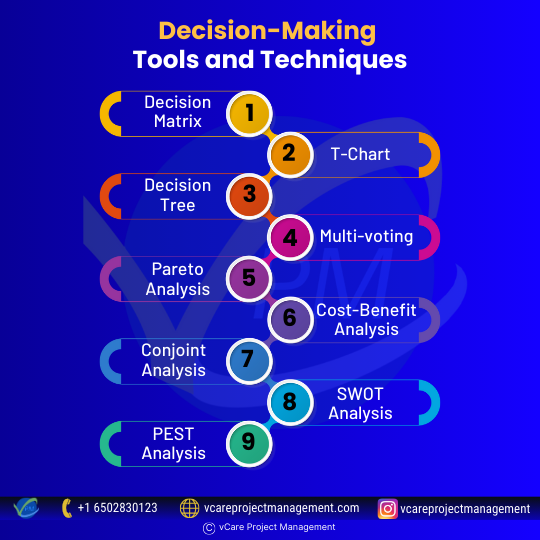
Decision-making Tools and Techniques
1. Decision Matrix: A decision matrix examines all of a choice’s possibilities. When utilizing the matrix, create a table with all the alternatives in the first column and the criteria influencing the decision in the first row. Users then rate each choice and choose which criteria are most important. After that, a final score is calculated to determine the best option.
2. T-Chart: This chart analyzes the benefits and drawbacks of the alternatives. It guarantees that all of the advantages and downsides are considered when deciding.
3. Decision Tree: This is a graph or model for assessing each option and its outcomes. This approach is also used for statistical analysis.
4. Multi-voting: This is utilized when multiple people decide. It helps narrow down many possibilities to a smaller one that leads to the final decision.
5. Pareto analysis: This technique is used when making many decisions. This analysis aids in selecting which decisions should be made first by calculating which ones will have the largest overall impact.
6. Cost-benefit analysis: This strategy assesses the financial implications of each feasible alternative to arrive at the most economical conclusion.
7. Conjoint analysis: Business leaders use this strategy to assess consumer preferences when making decisions.
8. SWOT Analysis: This planning tool examines SWOT (strengths, weaknesses, opportunities, and threats).
9. PEST Analysis: PEST, which stands for political, economic, social, and technical aspects, can help decision-making and timing by analyzing external factors. This method takes current trends into account to forecast future ones.
Importance of Decision-Making
Decision-making is an acquired skill rather than an inherent one that is in high demand in the workplace. However, employers consider it an appealing trait as it signifies a good leader. Therefore, demonstrating your decision-making abilities can help you advance your career and accomplish company objectives and goals.
Here are some of the benefits of making correct decisions:
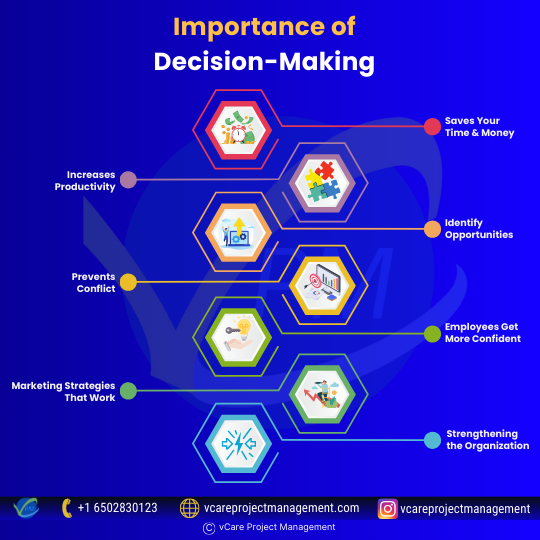
Importance of Decision-Making
1. Saves Your Time & Money
Ineffective decision-making requires some time and depletes the motivation of those engaged. The less time you waste making rapid decisions, the better. When it comes to running a business, time is money. Wasting time is the same as wasting money.
2. Increases Productivity
When management excels at making decisions and developing good ones, it will boost the workforce’s productivity. Employees will be motivated, for one thing, since they know where the organization is heading. They will strive with the conviction that their efforts will succeed. All time is preserved because the management team is convinced that their activities will correctly guide their organization.
3. Identify Opportunities
The key is to recognize the opportunities in front of you and be able to act on them. If there is a great demand for a product in the market and your firm can offer it, wrong or delayed decision-making may prevent you from focusing on it. On the other hand, poor decision-making can make opportunities appear nonexistent.
4. Prevents Conflict
A manager’s failure to make strong, fair decisions can lead to workplace conflict. Conflicts in the lower tiers also occur when management needs to be more assertive and leave more decisions to their employees. Good decision-making skills can prevent employee conflicts regarding which idea is better for their team or how to maintain a project.
5. Employees Get More Confident
Project leaders can become role models and show their employees they are good decision-makers. As a result, employees will trust and follow them confidently, even in the darkest times. When their staff feels that they trust their decisions at every moment, they are more likely to develop new innovative ideas that could benefit the overall business.
6. Marketing Strategies That Work
Several critical considerations must be made when implementing successful marketing campaigns. Decision-making is the most important factor in developing strategies and making them stand out. No matter how good the products or services are, the firm will only reach its full potential if it can effectively advertise its brand.
7. Strengthening the Organization
Everyone has an equal right to participate in the management of the organization. This aspect fosters a spirit of teamwork and solidarity among those who work there, improving the organization’s overall productivity and strengthening its general structure. Decision-making allows individuals working in an organization to convey their ideas equally.
Decision-making and its impact on problem-solving
The importance of decision-making in problem-solving is apparent and an essential component of efficient project management. A project manager’s capacity to make sound decisions and solve problems correctly is critical since it influences organizational functioning. Problem-solving and decision-making are sometimes inextricably linked; one must better decide to solve a problem.
Problem-solving is a key skill that makes one an excellent project leader. Problems are unavoidable when it comes to project management. Because we all encounter similar scenarios in our everyday lives, what makes a difference is knowledge and how well we use it to tackle a present or looming problem. In project management, problem-solving and resolution are strategic processes. As a result, one won’t be able to master that talent overnight. Instead, it requires incremental learning, using a framework, and preserving some critical factors.
Why are problem-solving skills necessary?
When potential employers discuss problem-solving, they aim to assess how team members use this talent to assist decision-making in the company’s day-to-day operations. Here are four reasons why problem-solving skills are vital in the workplace:
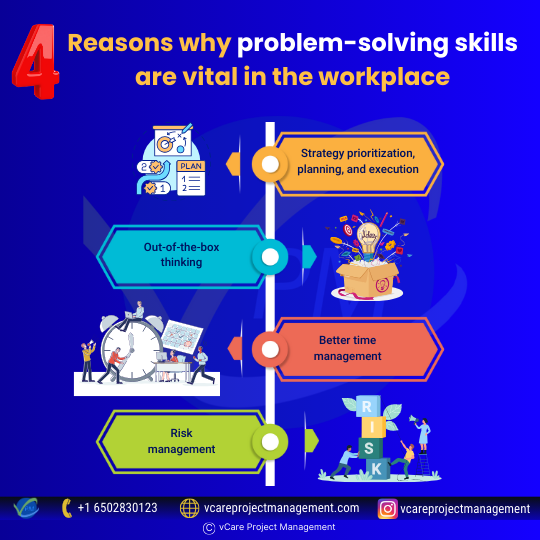
Four Reasons why problem-solving skills
1. Strategy prioritization, planning, and execution
Efficient problem solvers may thoroughly examine consumer requirements and devise a strategy that allows them to give outstanding service to their intended audience. Their expertise is in simplifying procedures by eliminating bottlenecks.
2. Out-of-the-box thinking
Problem-solving and creative thinking are inextricably linked. Finding a dynamic and innovative solution to a problem is not a matter of finding an instant solution but a dynamic and innovative solution. This mindset assists the company in staying ahead of the curve and gradually improving the workforce’s competence.
3. Better time management
When an issue emerges, it must be resolved as soon as possible. Employees with strong problem-solving abilities are laser-focused on what is critical to the organization, can roll with the punches, and can meet tight deadlines.
4. Risk management
Effective planning is a necessary problem-solving ability. Problem solvers may respond rapidly to short-term circumstances while keeping an eye on the future. Their positive approach toward learning agility enables them to foresee future challenges based on prior experiences, industry trends and patterns, and current events.
Problem-solving Techniques
Complex problems might be challenging to solve, yet difficulties can be addressed when the correct tools are used. Aside from sophisticated management tools, here are some tools and technologies that can help with problem-solving approaches in your everyday work.
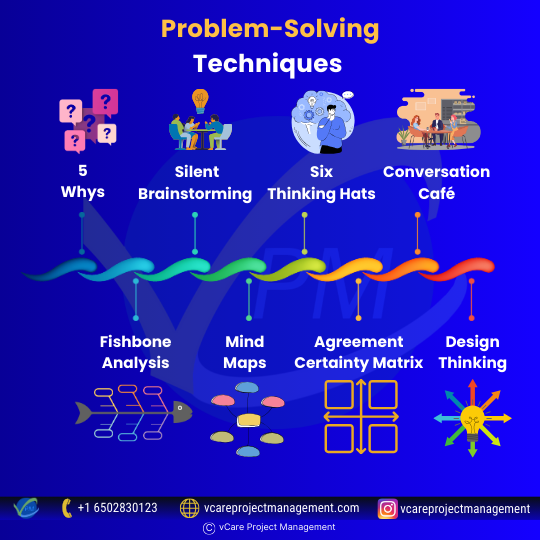
Problem-solving Techniques
• 5 Whys – Understanding the problem better is a wonderful strategy to find the core cause.
• Fishbone analysis – used to visualize the fundamental causes of an issue. Simple to use in conjunction with ‘5 Whys’ or ‘Mind mapping’ to brainstorm and discover the source and impact of any problem.
• Silent brainstorming – allows everyone to engage in idea generation since the loudest and quietest persons will contribute equally. This technique is useful because everyone’s point of view is equally valid.
• Mind maps – are organized visual representations that allow one to exchange ideas, thoughts, and solutions like your brain does. You immediately describe the issues, discuss new ideas, and eventually reach a team agreement that can lead to a successful solution.
• Six thinking hats – This technique allows your team to approach challenges from several perspectives, concentrating on facts, creative ideas, or why some solutions may not work.
• Agreement certainty matrix—another fantastic visual tool for brainstorming issues and challenges. It categorizes them as simple, complicated, complex, or chaotic domains to help teams agree on what technique should be utilized to handle the real problems impacting them.
• Conversation café – This allows the team to have constructive conversations with less argument and more active listening. The problem is addressed in rounds of dialogues until a consensus is reached on the best problem-solving technique.
• Design thinking – When you’re stuck for new ideas, the 5-step approach will help you empathize with the problem, then define and create new concepts before prototyping and testing them.
What are the critical problem-solving skills?
Problem-solving skills enable firms to seek and recruit intellectually equipped personnel who can handle anything their professions throw at them. Problem solvers can watch, assess, and act quickly when the situation demands it- without negatively impacting the business. The following are the top problem-solving skills in the workplace:
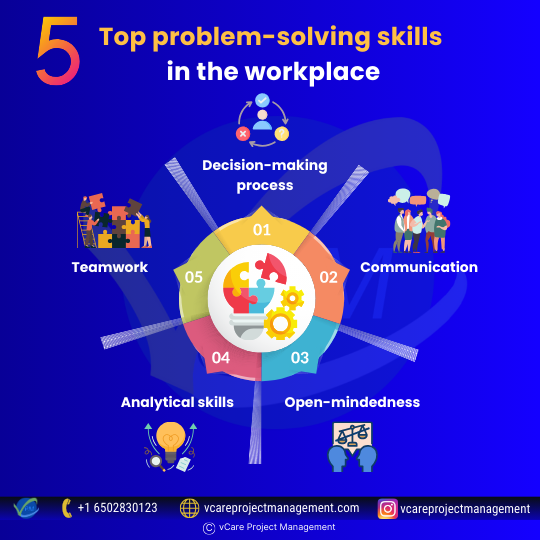
Five Top problem-solving skills
1. Decision-making process
Problem-solving requires the ability to make decisions. One can only solve it if one fully comprehends the issue and decides to take action. Decision-making abilities enable experts to rapidly choose between two or more solutions after weighing the benefits and drawbacks of each.
2. Communication
Communicating the problem and offering remedies vocally and in writing is an art in and of itself. However, proper communication ensures that solutions are implemented successfully and that all parties engaged in the disagreement agree.
3. Open-mindedness
Open-mindedness is the readiness to explore new ideas and look at things from a new viewpoint. When faced with an issue, consider all of its viable solutions. Being curious and observant allows one to be a better problem solver.
4. Analytical skills
Almost all problem-solving scenarios need analysis, such as predicting, critical thinking, or troubleshooting. Analytical skills allow one to comprehend the situation better and generate effective answers based on facts and data.
5. Teamwork
Collaboration is essential for keeping communication lines open, problems cooperatively addressed, and the team aims before personal ambitions.
Team dynamics are important in problem-solving because they allow one to work together with others toward a common objective.
Final Thoughts
The majority of problems start modestly. Creative program/portfolio managers are responsible for finding solutions as quickly as feasible. The longer they wait, the worse the situation will get.
They may break out of that cycle with a strategic problem-solving framework and quickly find solutions to difficulties using ideal project management automation technology. However, making decisions is crucial to solving problems. Making decisions may be a painstaking process in project management. However, the decisions made inside the team significantly impact a project’s success.
In the future of employment, net new jobs will be created at the same pace as dying jobs. Human talents such as creativity, decision-making, problem-solving, invention, and critical thinking will become more in demand as technology replaces employment requiring repetitive and boring operations. Organizations that get a head start on measuring these human talents in their workforce now and provide strategic learning and development opportunities to upskill them will gain a competitive edge as we enter the Fourth Industrial Revolution.
Jobs we will never see coming will rise rapidly in the future of work (or what many call “The Fourth Industrial Revolution”). The “proper” professional path or education of an ideal individual for these professions will not be clear. We will need to quantify people’s human talents to position them in positions; not only are these skills transferable across unconventional career choices, but these distinctive human skills will also be protected against automation.
Thus, advanced certifications like PMP®, Agile, PgMP®, and PfMP® certifications can help one develop project management skills, be a good problem solver, be a more competitive candidate for positions, and be a successful project leader. In today’s competitive business world, one must be skilled and experienced to succeed and grow one’s career.




























